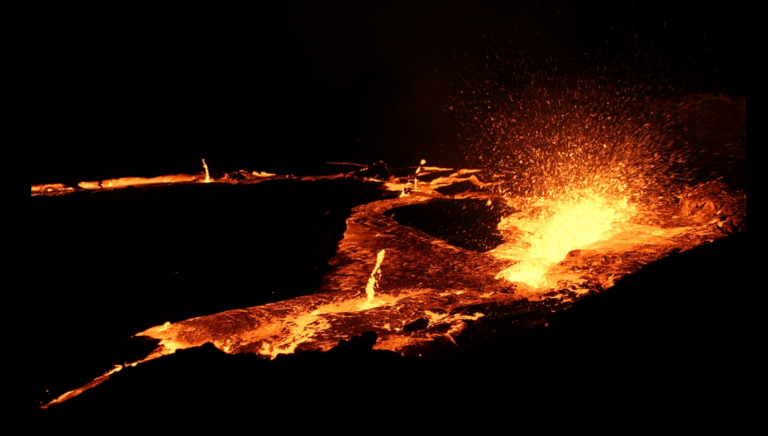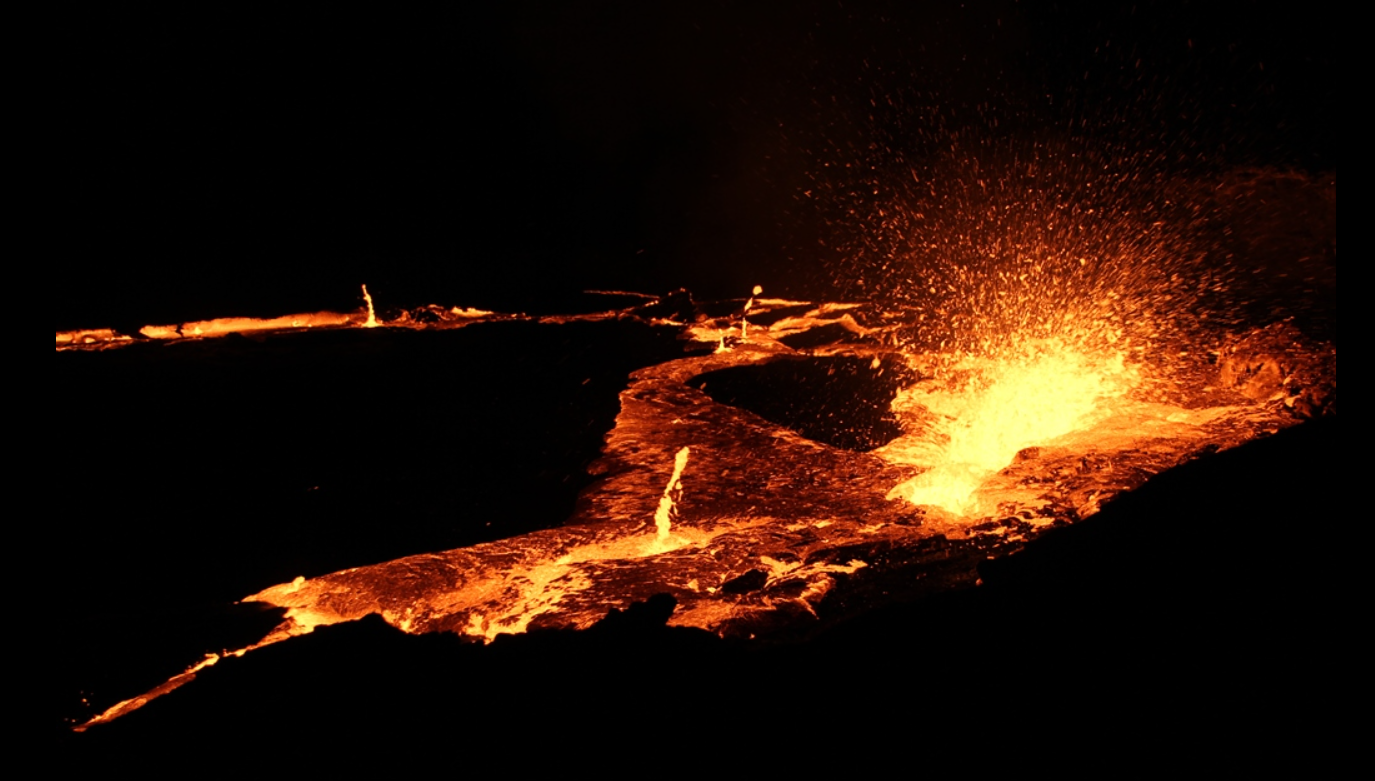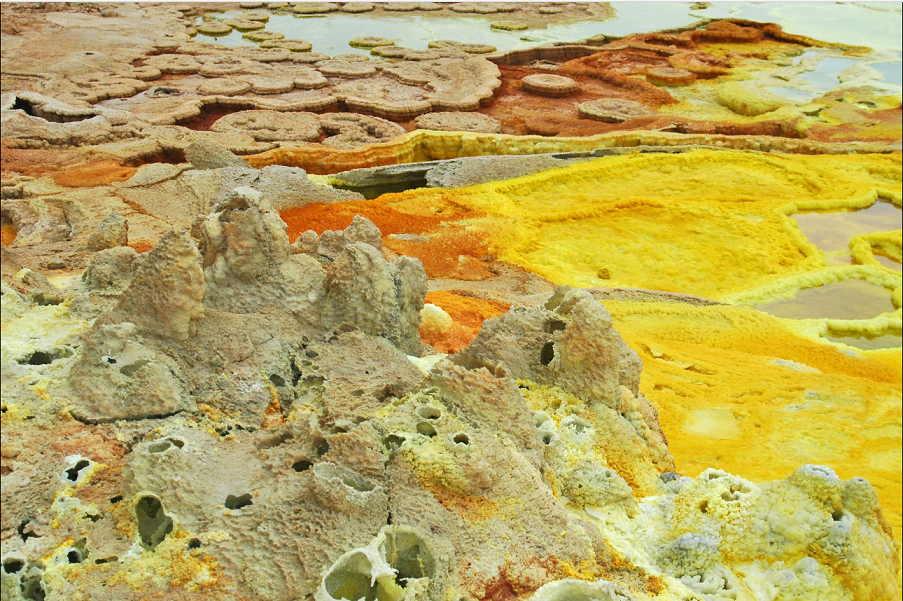
When Three Plates Collide
The Danakil Depression is the northern part of the Afar Triangle or Afar Depression in Ethiopia, a geological depression that has resulted from the presence of three tectonic plates in the Horn of Africa. It has developed as a result of Africa and Asia moving apart, causing rifting and volcanic activity. Erosion, inundation by the sea, the rising and falling of the ground have all played their part in the formation of this depression. Sedimentary rocks such as sandstone and limestone are unconformably overlain by basalt which resulted from extensive lava flows.
Volcano erupting within the Danakil Depression
Hot springs in the Danakil Depression
The Danakil Depression is the hottest place on Earth in terms of year-round average temperatures. With a high of 52° C it has often been referred to as the ‘Gateway to Hell’. It is also one of the lowest places on the earth (100 m below sea level), and without rain for most of the year. Here, the Awash River dries up in a chain of salt lakes such as Lake Afrera, never reaching the Indian Ocean.
Mount Ayalu is the westernmost and older of the two volcanoes at the southern end of the Danakil Depression. The other active volcano, Erta Ale, is one of several crater lakes of lava bubbling from the Earth’s mantle. Additionally, the area contains the Dallol sulfur springs, or hot springs.
‘Double, double toil and trouble, fire burn, and cauldron bubble’. Macbeth, Shakespeare
In 2005, a giant rift was formed in just a few days. The rift opened when the Dabbahu Volcano, situated in the north of the region, erupted. The crack forming is thought to be part of the process in which the Arabian Plate and African plates are moving apart. This new crack, 500 metres (1,640 ft) long, and 60 metres (197 ft) deep, opened when the lava from the erupting volcano flowed underground and cooled forming a 60 kilometres (37 mi) long, 8 metres (26 ft) wide dike within days.
The Birth of an Ocean, Afar, Ethiopia
You would think that this extreme environment is not a place for human habitation yet you would be wrong both today and in the past. Afar was the site of the discovery in 1973-74 of “Lucy”, the Australopithicus afarensis skeletal remains. In 2005, another skeleton, estimated to be 3.8 million years old and said to be the world’s oldest bipedal hominid skeleton, was found in the region.
In 2006 it was reported that a “significantly complete” cranium had been found at in the Gona area. The cranium appears as an intermediate form between Homo erectus and Homo sapiens.
In 2009, scientists reported that they had found a skeleton, which dates around 4.4 million years ago. The specimen is a distant cousin of the Australopithecus afarensis, Lucy’s species.
In June 2010, the oldest direct evidence of stone tool manufacture was found in the Afar region and attributed to Australopithecus afarensis.
In 2013, a hominid jawbone was discovered in the Ledi-Geraru region of Afar. Scientists estimated that the fossil dates back around 2.8 million years ago, which is 400,000 years before the next oldest hominid fossil remains.
In 2015, a hominin jawbone and teeth was discovered in the Afar region. Scientists believe that the bones belonged to a previously undiscovered ancestor.
Based on the 2007 Census conducted by the Central Statistical Agency of Ethiopia (CSA), the Afar Regional State today has a population of 1,390,273.
Rifts represent part of an evolutionary sequence of crustal and upper mantle stretching that leads to normal faulting resulting from extension. Rift basins, as a distinct geological category, account for only about 5% of the area of basins of the world, however understanding rift systems helps to unravel a very large portion of the earth’s geology. Rift basins also occur throughout the geological record with examples from the Palaeozoic, Mesozoic and the Cenozoic.
In addition to rift basins being the foundation of much of the geological history of the earth, they are additionally extremely attractive areas for hydrocarbon accumulations. Despite their relatively small geographical distribution, they are known to account for 12% of the known oil reserves.
If you would like to know about rift systems and in particular the features that make them so attractive to oil and gas exploration, development and production, then PetroKnowledge is running an intensive training course on Seismic Interpretation and Basin Analysis of Rift Basin Systems. This is to be held in Dubai from the 24th until the 28th September 2017.



